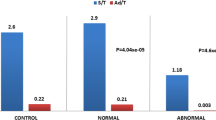Summary
Leydig cell number was evaluated quantitatively in testicular biopsies from post-pubertal cryptorchid patients and normal controls. For this quantitative evaluation we used the following method. This is based on the determination of the total number of Leydig cells, Leydig cell clusters and seminiferous tubules in the entire histologic sections of each biopsy and the determination of the following indices; mean Leydig cells per tubule, mean Leydig cell clusters per tubule and mean Leydig cells per cluster. In addition, the numbers of Sertoli cells were counted, and Leydig-Sertoli cell ratio was also determined. These indices were correlated with each other. All indices were significantly elevated not only in undescended but in contralateral scrotal testes of the cryptorchid patients in comparison to those in normal controls. Between undescended and descended scrotal testes of the same individual patients, those indices were significantly higher in the descended scrotal testes than in the undescended ones. Thus, Leydig cell hyperplasia was noted in the testes of post-pubertal cryptorchid patients, and was more prominent in the contralateral scrotal testes than in the undescended ones.
Similar content being viewed by others
References
Hellinga G (1964) Fertility after hormonal or surgical treatment from bilateral cryptorchidism. Symposium Int Fertil Ass 25:4
Nicole R, Spindler B (1964) Prognosis as to fertility following operations for cryptorchidism in children. Hormon 25:6
Numanoglu I, Köktürk I, Mutaf O (1969) Light and electron microscopic examinations of undescended testicles. J Pediatr Surg 4:614
Leeson CR (1966) An electron microscopic study of cryptorchid and scrotal human testes with special reference to pubertal maturation. Invest Urol 3:498
Daniel DF (1969) Abnormal sexual development. Saunders Co, Philadelphia London Toronto, p 146
Mancini RE, Rosemberg E, Cullen M (1964) Cryptorchid and scrotal human testes. I: Cytological, cytochromical and quantitative studies. J Clin Endocrinol 25:927
Williams RH (1974) Textbook of endocrinology. 5th ed. WB Saunders Co, Philadelphia London Toronto, p 357
Hadziselimovic F (1977) Cryptorchidism: Ultrastructure of normal and cryptorchid testis development. Adv Anat Embryol Cell Biol 53:1
Blundon KE, Russi S, Bunts RC (1953) Interstitial cell hyperplasia or adenoma. J Urol 70:759
Dubin L, Hotchkiss RS (1969) Testis biopsy in subfertile men with varicocele. Fertil Steril 20:50
Sohval AR (1954) Histopathology of cryptorchidism. Am J Med 16:346
Weiss DB, Chowdhury A, Steinberger E (1978) Quantitation of Leydig cells in testicular biopsies of oligosperic men with varicocele. Fertil Steril 30:305
Leeson TS, Leeson CR (1970) Experimental cryptorchidism in the rat: a light and electron microscopic study. Invest Urol 8:127
Heller CG, Lalli MF, Pearson JE, Leeson DR (1971) A method for the quantification of Leydig cells in man. J Reprod Fertil 25:177
Abraham VR, Born HJ, Collischonn G, Dericks-Tan JS, Janbert HD (1973) Testosterone biosynthesis in spontaneous dystopic rat testes with genetic descensus disorder. Endokrinologie 62:368
Eik-Nes KB (1966) Secretion of testosterone by the ectopic and the cryptorchid testis in the same dog. Can J Physiol Pharmacol 44:629
Kormano M, Härkönen M, Kontinen E (1964) Effect of experimental cryptorchidism on the histochemically demonstrable dehydrogenases of the rat testis. Endocrinology 74:44
Raboch J, Starka L (1972) Plasmatic testosterone in bilateral cryptorchids in adult age. Andrologie 4:107
Kodaira T (1976) Endocrinological studies on cryptorchidism. Part 2. Reference of androgen biosynthesis of testes, especially in human cryptorchidism. Jpn J Urol 67:795
Okuyama A, Itatani H, Mizutani S, Sonoda T, Aono T, Matsumoto K (1980) Pituitary and gonadal function in prepubertal and pubertal cryptorchidism. Acta Endocrinol 95:553
Lipschultz LI, Caminos-Torres R, Greenspan CS, Snyder PJ (1976) Testicular function after orchiopexy for unilaterally undescended testis. N Engl J Med 295:15
Reviewer's Comment
Läckgren G, Ason Berg A (1983) In vitro metabolism of progesterone by the human undescended testis. Int J Androl 6:423–431
Had ziselimovié F (1977) Cryptorchidism. Adv Anat Embryol Cell Biol. Springer, Berlin Heidelberg New York
Author information
Authors and Affiliations
Rights and permissions
About this article
Cite this article
Gotoh, M., Miyake, K. & Mitsuya, H. Leydig cell hyperplasia in cryptorchid patients: Quantitative evaluation of Leydig cells in undescended and contralateral scrotal testes. Urol. Res. 12, 159–164 (1984). https://doi.org/10.1007/BF00255915
Accepted:
Issue Date:
DOI: https://doi.org/10.1007/BF00255915




